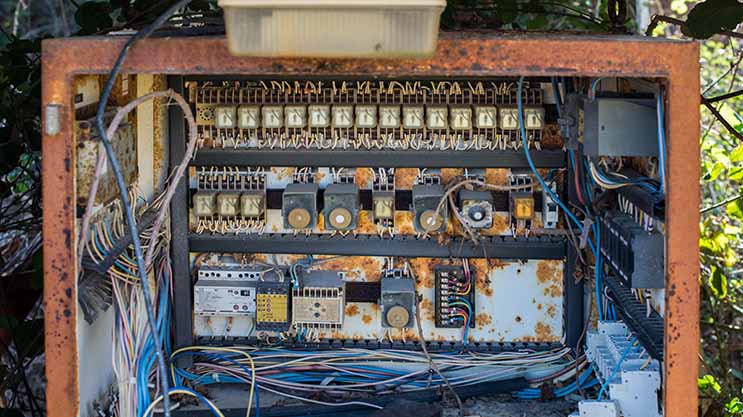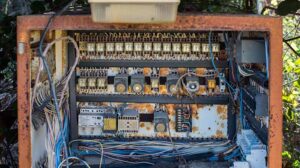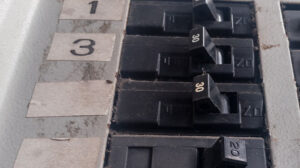Water in an electrical panel can be a serious problem that requires immediate attention. It can lead to electrical fires, short circuits, and other dangerous situations. Therefore, it’s important to know what to do if you have noticed water, moisture, or corrosion in your electrical panel.
Before we discuss further, we must discuss that water in an electrical panel is dangerous. When it comes to water and electricity, the obvious danger is a shock hazard. If you do not have a method of turning the power off to the panel, or if you’re wondering about the safety of doing the inspection yourself, it may be a good idea to have a professional come in and look at it for you.
If you would like to inspect the panel yourself, here are some simple steps to take:
Step One: Turn off the power to the panel
First and foremost, if you discover water in your electrical panel, you should turn off the power to the panel immediately. This can usually be done by flipping the main breaker switch or unplugging the main power source.
It’s important to do this before attempting to address the water issue, as working on an electrical panel while it is still energized can be extremely dangerous.
To shut off an electrical panel, you will need to locate the main breaker switch or the main power source. The main breaker switch is typically a large switch that is located at the top or bottom of the panel. It is often labeled “main” or “main breaker.” To turn off the power, you will need to flip the switch to the “off” position.
If you are unable to locate the main breaker switch, or if it is not functioning properly, you can also unplug the main power source. The main power source is typically a large cord that runs from the panel to an outlet or a junction box. To unplug the power, you will need to locate the plug and carefully pull it out of the outlet or junction box.
It’s important to note that you should only shut off the power if it is safe to do so. If you are unsure of how to safely shut off the power, or if you are concerned about the stability of the panel, you should call a professional electrician for assistance.
Step Two: Inspect for damage
Once the power is off, you should inspect the extent of the water damage.
If the water is only present in a small area, it may be possible to simply dry the area and repair any damaged components. However, if the water has caused widespread damage or has penetrated deep into the panel, it may be necessary to replace the entire panel.
This is also a good time to note whether or not you have an old electrical panel that needs replacing.
If the water damage is limited, you should start by drying the area as much as possible. You can use towels, a hair dryer, or a dehumidifier to help remove the moisture. Be sure to dry the area thoroughly, as any remaining moisture can lead to further damage or even create a risk of electrical shock.
After the area is dry, you should inspect all the electrical components for damage. If any wires or other components are damaged, they should be replaced. This may require the assistance of a professional electrical service, as working with electrical wires can be dangerous if you are not properly trained.
If the water damage is more extensive and requires the replacement of the entire panel, it’s important to hire a professional electrician to handle the job. A professional electrician will have the knowledge and expertise to properly install a new panel and ensure that it is safe and up to code.
Step Three: Prevent future damage
In addition to addressing the immediate issue of water in the electrical panel, it’s important to try to prevent water damage in the future. One way to do this is by inspecting and maintaining the exterior of your home.
Make sure that your roof is in good repair and that there are no leaks or other sources of water infiltration. You should also inspect your gutters and downspouts to ensure that they are functioning properly and directing water away from your home.
You should also make sure your panel is sealed off and waterproofed with sealant in areas where water may come into contact with parts of the panel. Additionally, you should check for any signs of corrosion or moisture buildup on the circuit breaker boxes, switches, and surrounding components.
If you have a basement or crawlspace, it’s important to keep these areas dry as well. Consider installing a sump pump to help remove excess water, and make sure to seal any cracks or gaps that could allow water to enter the space.
Finally, it’s a good idea to invest in a whole-home surge protector. These devices can help protect your electrical system from power surges and other electrical issues that can lead to water damage.
In summary, water in an electrical panel is a serious issue that requires immediate attention. If you discover water in your electrical panel, turn off the power and inspect the extent of the damage. You may also consider getting a full electrical inspection of your home or property.
If the damage is limited, dry the area and repair any damaged components.
If the damage is more extensive, hire a professional electrician to replace the panel (we do not recommend attempting to replace your electrical panel yourself). To prevent future water damage, maintain the exterior of your home, keep your basement or crawlspace dry, and invest in a whole-home surge protector.







